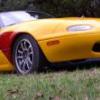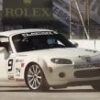The minute we start throwing a double yellow for everything...the debate will change to "let us race"...we can see!
What I would like to see is consistancy among SCCA...and always error on the side of a little extra safety.
Disclaimer: I wasn't at this race, I'm new to racing and have never worked a corner. So, I don't claim to be an expert about any those aspects. I hate second guessing, and monday-morning quarterbacking.
That said, I was at NASA race in April under almost exactly the same muddy, wet conditions. If you go off in either turn 1 or turn 7 (and a few others), there is a very high probability that you are going to follow the exact same trajectory as any other car that goes off in the same corner. Both turns are high speed, and flat-out. Turn 1 is a little bit better because there is more pavement from the racing line to the outside edge to maaaybe manipulate your ultimate path. But, in turn 7 you're going off in a hurry, and once you hit the grass you are a billiard ball.
The conditions present in april (and presumably at this event too) make the off-track surface an ice-rink, and once you leave the surface (even two wheels) you are nothing more than a projectile. So, if you go off in the same place, you will end up in the same place. We all discussed that in depth at the driver's meeting in april. In april we altered the usual NASA 3/4 car-width rule (to 1 full width, plus a little) to help prevent anyone dropping wheels and becoming a projectile. Also, in april **most** off-track incidents became FCY rather quickly--there were a couple of notable exceptions.
If you stop the video as soon as Willie's car is in view you can see the tracks from each car and you can see that this was inevitable the instant willie left the racing surface. Arguably, it was set the second Willie's car lost control. The video starts with Lee already stopped, and its 49 seconds from then before the crash occurs. It does not appear that the yellow was ever displayed at the T7 corner station---thus I'm assuming not at the T6 station either.
It would seem that in these types of situations where it is known in advance that there is no traction off the racing surface and cars already OFF will be susceptible to a high-speed impact (from a car in a similar follow-up projectile situation) that FCY should be more immediate. if better more concrete guidance can be provided on these types of special situations, then the FCY or even local waving yellow can be more quickly displayed and lessen the chance of a repeat occurence.
Again, in some respects I hate this kind of second guessing. And, even though I'm doing it (with some level of admitted naivity), it is NOT out of an interest in blaming those who were there and had to make whatever split second decision they did. It is only out of an interest in assessing if there is anything to learn from the incident.
I can and have accepted the risk of going home with a broken car, ribs, even limbs, or a concussion. But, the risk of death, paralysis, or multiple vertebral fractures should be as far off the table as possible.




 Sign In
Sign In Create Account
Create Account












 Back to top
Back to top Report
Report




















